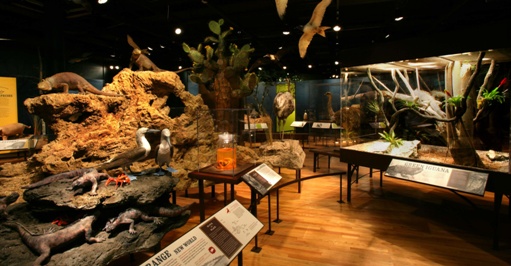The Natural History Museum, London
14 November 2008 - 19 April 2009
Open 10.00 - 17.30 daily; last admission 17.00
Adults: £8.80, Concessions: £5.90,
Children: £4.40, Families: £23.50,
Members, Patrons, children aged 3 and under: Free

Sarah Day, the Society’s Earth Science Communicator, popped down the road to the NHM’s latest contribution to the 2009 Darwiniana...
“There’s nothing like geology. The pleasures of the first days partridge shooting…cannot be compared to finding a fine group of fossil bones, which tell their story of former times with almost a living tongue”.
So wrote the young Charles Darwin, in a letter sent home during his seminal voyage on The Beagle. The story of how the young Cambridge graduate, as confused about what direction to take his life in as most graduates are, embarked on the voyage of a lifetime, returned a hero of science and went on to publish one of science’s most influential theories, is well known. By the end of 2009, Darwin’s bicentennial and the 150th anniversary of the publication of On the Origin of Species, it will probably be as well known as the Nativity. But extracts such as this suggest there are many more facets to Darwin than those we learn from the just-so story of his life. Not least is that he could just as easily be labelled a geologist as a biologist, botanist or zoologist.
This multidisciplinary approach to science by Darwin is perfectly captured in the Natural History Museum’s current exhibition, ‘Darwin’s Big Idea’, which runs until 19 April. Although the title might suggest the exhibition focuses exclusively on evolutionary theory, it is really a sprawling, epic mishmash of the various objects, theories and ideas which contributed to Darwin’s fascinating life. What binds them all together is not the theory, or even science, but Darwin himself.
The exhibition takes visitors on an aptly winding path through Darwin’s internal journey, beginning with the build up to his trip on The Beagle. This is complete with the various objects he took with him, including a tiny pistol and a rock hammer, and the concerned correspondence between his father and the trip’s champion, Josiah Wedgewood. On the way we meet a huge variety of exhibits, including letters, specimens, digital displays and Charlie the Green Iguana who, alongside an Ornate Horned Frog, help to give a flavour of the types of creatures Darwin met on the trip.
The exhibition itself is wonderfully multidisciplinary, refusing to restrict itself to simply a scientific or a personal narrative. Videos of scientists giving their own reflections on the nature of theories and evidence lend a philosophical flavour, whilst there is a section devoted to demonstrating evolution through various examples for those who are keen for some more straightforward science. Among the most fascinating moments, however, are those which give some insight into the personal lives of the protagonists, venturing of the well-beaten track of the familiar Darwin story. A note on the pros and cons of marriage (‘an object to be beloved and played with: better than dog’) is a highlight, as is a box containing various objects collected by his beloved daughter, Annie. Another familiar theme, that of Darwin’s internal religious conflict, is well treated by not being overemphasised. This is not a ‘science vs religion’ exhibition, but little touches like a letter from his wife Emma, outlining her concerns about his doubt, give a sense of what was at stake. Darwin’s reply, written at the bottom, shows only too plainly the deeply personal nature of the question: ‘when I am dead, know that many times, I have kissed and cried over this’.
Somewhere in among all these themes, geology is not forgotten. Darwin’s notes made on the Beagle include 1,383 on geology, compared to a mere 368 about animals. Among them are observations of the effects of an earthquake in Chile, during which a bank of mussels were raised eight feet, prompting Darwin to muse about what processes might have raised mountains over longer time periods. Amid all the 2009 Darwin-related hype, there is likely to be no end of jostling between various scientific groups as to who can claim the great man as one of his own. The biologists lay claim on the grounds his evolutionary work, the zoologists can point out his passion for collecting specimens - whether beetles or Galapagos finches – and the geologists, of course, can point out that Darwin was first and foremost an earth scientist.
All of which seems a little bit silly, like arguing over whether Barack Obama is ‘really’ Irish, American, Hawaiian or Kenyan. He is, or course, a bit of all of them. That’s the beauty of science – if it’s really interesting it never quite fits into any predefined subject areas. It’s also what makes historical science particularly interesting, as these crossovers were much more frequent, and far less controversial that they seem to be now. The great strength of the exhibition is its ability to capture this sense of spreading across boundaries and encompassing endlessly varied fields of thought. Scientists, as well as members of the public, might learn much from it.